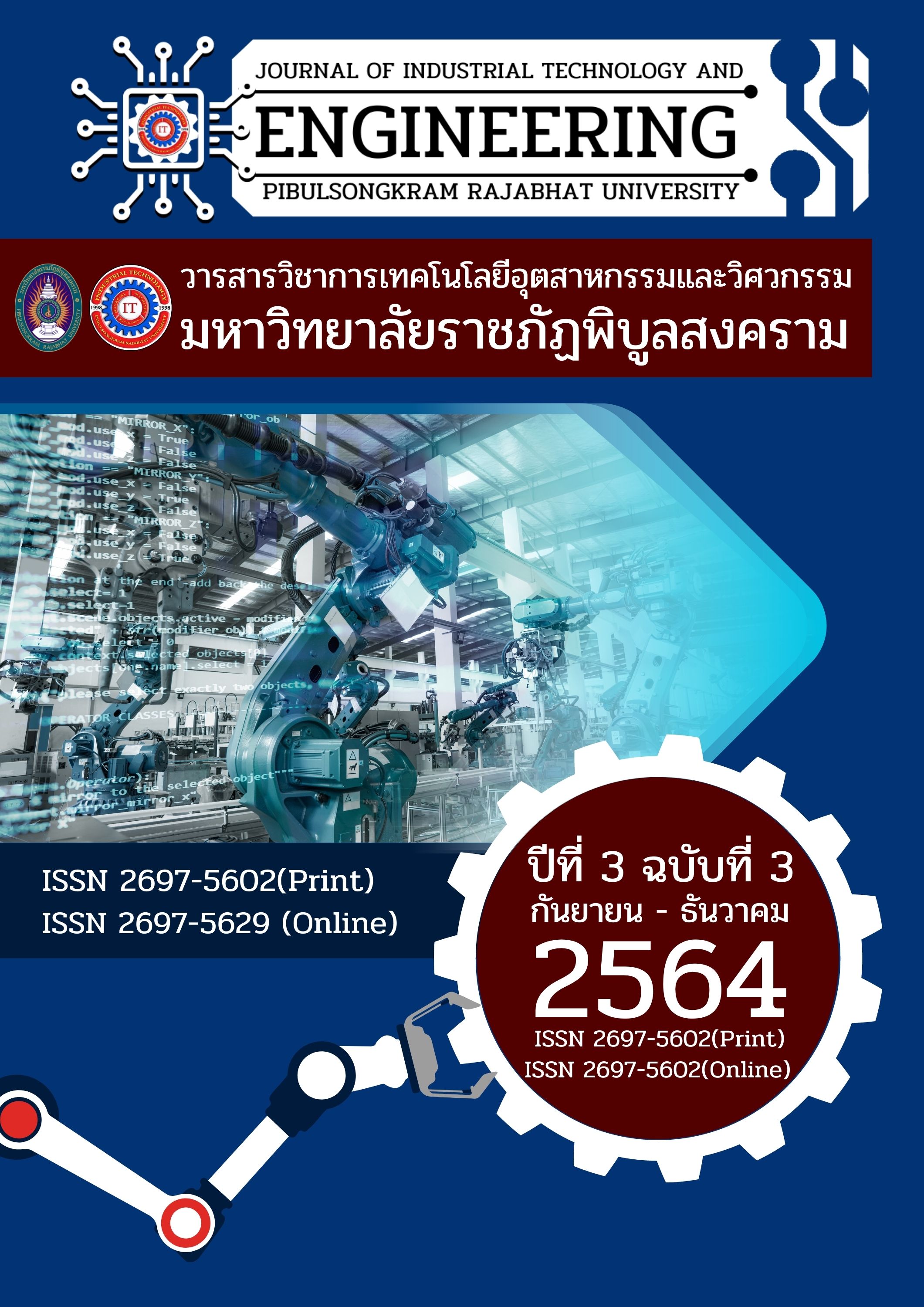สภาวะที่เหมาะสมของกระบวนการชุบผิวแข็งด้วยเปลวไฟ เหล็กกล้าคาร์บอน AISI 1045 โดยวิธีทากูชิ
คำสำคัญ:
การชุบผิวแข็งด้วยเปลวไฟ, เหล็กกล้าคาร์บอน, วิธีทากูชิบทคัดย่อ
งานวิจัยนี้มีวัตถุประสงค์เพื่อศึกษาสภาวะที่เหมาะสมในการชุบผิวแข็งเหล็กกล้าคาร์บอน AISI 1045 ด้วยเปลวไฟโดยวิธีทากูชิ ซึ่งประกอบด้วย 3 ปัจจัยหลักได้แก่ อุณหภูมิชุบผิวแข็ง ระยะห่างของหัวฉีดแก๊สกับชิ้นงาน และความเร็วรอบการหมุนของชิ้นงาน ผลการศึกษาพบว่าสภาวะที่เหมาะสม คือ การใช้อุณหภูมิ 950 องศาเซลเซียส ระยะห่างของหัวฉีดแก๊สกับชิ้นงาน 30 มิลลิเมตร และความเร็วรอบการหมุนของชิ้นงาน 2 รอบต่อนาที ให้ค่าความแข็งสูงสุด (HRC) ที่ 54.12 และค่าอัตราการสึกหรอต่ำสุด 0.0582 กรัม และผลจากการวิเคราะห์ความแปรปรวนของปัจจัย พบว่าทุกปัจจัยส่งผลต่อการชุบผิวแข็งด้วยเปลวไฟอย่างมีนัยสำคัญที่ระดับความเชื่อมั่น 95 เปอร์เซ็นต์ ซึ่งสามารถนำไปเป็นแนวทางในการปรับปรุงสมบัติผิวของชิ้นส่วนเครื่องจักรกลเพื่อยืดอายุการใช้งาน
เอกสารอ้างอิง
2. Asiltürk, I., & Akkuş, H. (2011). Determining the effect of cutting parameters on surface roughness in hard turning using the Taguchi method. Measurement, 44(9), 1697–1704.
3. Chucheep, T., Mahathaninwong, N., Janudom, S., & Wannasin, J. (2017). Effect of Flame Hardening Temperature on Hardness and Wear Properties of Band Saw Steel. ASEAN Journal of Scientific and Technological Reports, 20(1), 67-74.
4. Dossett, J. L., Totten, G. E., & ASM Handbook Committee (Eds.). (2013). ASM Handbook: Steel Heat Treating, Fundamentals and Processes. Volume 4A. Asm International.
5. Freeman, K. P., Cook, J. R., & Hooijberg, E. H. (2021). Introduction to statistical quality control. Journal of the American Veterinary Medical Association,
258(7), 733-739.
6. Makrahy, M. M., Ghazaly, N. M., Abd El-Gwwad, K. A., Mahmoud, K. R., & Abd-El-Tawwab, A. M. (2013). Optmization of operation parameteres on
a novel wedge disc brake by taguchi method. American Journal of Vehicle Design, 1(2), 30-35.
8. Grönegress, H. W. (2013). Flame hardening. Springer Science & Business Media.
9. Jeyaraj, S., Arulshri, K., Harshavardhan, K., & Sivasakthivel, P. (2015). Optimization of Flame Hardening Process Parameters Using L9 Orthogonal Array of Taguchi 10. Approach. International Journal of Engineering and Applied Sciences, 2(3), 257976.
11. Kim, G. H., Lee, M. K., Kim, G. M., Hong, S. M., Kim, W. W., & Rhee, C. K. (2006). Optimization of Movable Flame Hardening Process for the Turbine Blade 12Cr Steel. Solid State Phenomena, 118, 185–190.
12. Lee, M. K., Kim, G. H., Kim, K. H., & Kim, W. W. (2004). Control of surface hardnesses, hardening depths, and residual stresses of low carbon 12Cr steel by flame hardening. Surface and coatings technology, 184(2-3), 239-246.
13. Lee, M. K., Kim, G. H., Kim, K. H., & Kim, W. W. (2006). Effects of the surface temperature and cooling rate on the residual stresses in a flame hardening of 12Cr steel. Journal of Materials Processing Technology, 176(1–3), 140–145.
14.Taguchi, G., Chowdhury, S., Wu, Y., Taguchi, S., & Yano, H. (2005). Taguchi's quality engineering handbook. Wiley-Interscience.
15. Dargacz, M., & Starosta, R. (2018). Influence of flame heating parameters on the hardness of hardened C45 steel. Journal of KONES, 25.
16. Thipprakmas, S. (2011). Improving wear resistance of sprocket parts using a fine-blanking process. Wear, 271(9-10), 2396-2401.
17. Woldman, M., Tinga, T., Van Der Heide, E., & Masen, M. A. (2015). Abrasive wear based predictive maintenance for systems operating in sandy conditions. Wear, 338, 316–324.



